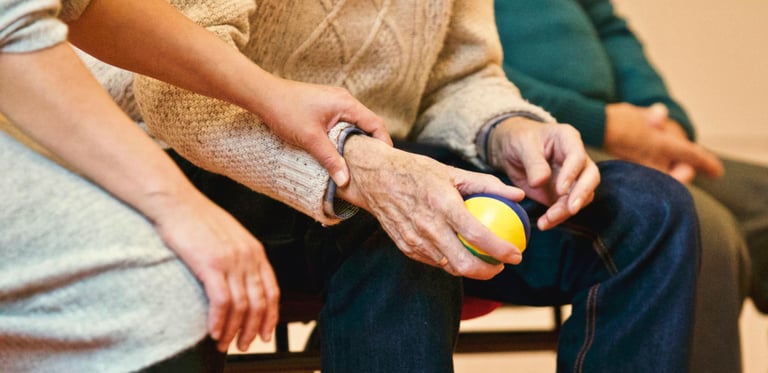How My Home Physical Therapy Helps Patients with Parkinson’s Disease


By Dr. Ryan Koelling, DPT


How My Home Physical Therapy Helps Patients with Parkinson’s Disease
9/02/25 | 1 min read
💭 Key Insights
We help improve balance and walking to lower the risk of falls.
Therapy focuses on everyday tasks like standing, walking, and moving around the house.
We teach caregivers safe ways to help and give patients exercises they can do daily.
Living with Parkinson’s Disease
Parkinson’s disease is a progressive neurological condition that affects movement, balance, and daily independence. Common symptoms include tremors, muscle stiffness, slowed movement, and challenges with posture. These symptoms often make leaving the home difficult, and frequent trips to a physical therapy clinic can become overwhelming for both patients and caregivers.
That’s where in-home physical therapy makes a difference. At My Home Physical Therapy, we bring skilled, personalized care directly to your living room, helping you or your loved one stay safe and active without the added stress of traveling.
Why In-Home Physical Therapy Matters for Parkinson's
Recent studies have shown that home-based therapy programs for individuals with Parkinson’s disease lead to significant improvements in mobility, balance, and quality of life—comparable to clinic-based programs.
Benefits include:
- Safety and convenience: Therapy is provided in a familiar environment, reducing anxiety and fall risks.
- Personalized exercises: Programs are tailored to your exact needs and goals.
- Home modifications: Therapists identify hazards such as poor lighting or clutter that could increase fall risk.
- Caregiver support: Family members can be included in sessions to better understand exercises and ways to help.
Living with Parkinson’s disease presents unique challenges, but with in-home physical therapy, patients don’t have to face them alone. At My Home Physical Therapy, we combine clinical expertise, personalized exercise programs, and home safety strategies to improve movement, independence, and quality of life.
If you or your loved one is living with Parkinson’s disease in Erie, Lafayette, Boulder, Longmont, Louisville, Superior, Broomfield, Brighton, or surrounding areas, we’re here to help—right in the comfort of your home.
Conclusion
What a Session Looks Like
How We Support Caregivers Too
Exercise and Strategies That Work
What the Research Says
1. Assessment of mobility, gait, balance, and home safety.
2. Custom exercise program targeting strength, flexibility, and endurance.
3. Practical safety tips such as where to add grab bars or improve lighting.
4. Caregiver training to reinforce exercises and safe mobility strategies.
5. Progress review to track improvements and adjust goals.
Parkinson’s doesn’t just affect the patient—it affects the entire family. We include caregivers in our sessions, offering guidance on safe transfers, daily mobility strategies, and ways to encourage exercise between visits. Research shows that joint participation—such as caregiver-patient exercise routines—improves outcomes for both the patient and caregiver.
Our therapists use research-backed approaches to target Parkinson’s symptoms, such as:
- Balance and Gait Training: Walking drills, rhythmic stepping, and heel-to-toe movements to reduce fall risk.
- Strengthening Exercises: Targeting the legs, hips, and core to improve stability.
- Flexibility and Stretching: Reducing stiffness and rigidity that limit mobility.
- Aerobic Activity: Gentle cycling, marching in place, or modified treadmill walking to improve endurance.
- Creative Engagement: Activities like Tai Chi and even dual exercises with caregivers (such as tandem cycling) have been shown to boost mobility and mood.
A study on home-based physiotherapy for Parkinson’s patients found improvements in functional mobility and independence.
- Structured home exercise programs were shown to improve balance and gait in people with Parkinson’s, even without frequent clinic visits.
- Hybrid programs (home visits plus telehealth) are equally effective in reducing symptoms and enhancing quality of life.
In other words, science supports what we see every day: home therapy works.
References
Impact of Homecare Physical Therapy on Parkinson’s Patients – Research, Society and Development Journal
Home-Based Exercises Improve Balance in Parkinson’s Disease – Journal of Physiotherapy
Home vs. Telerehabilitation for Parkinson’s Disease – Journal of Clinical Medicine
Tai Chi and Parkinson’s Disease – Health.com
Tandem Cycling Study in Parkinson’s Patients – NY Post
Want to learn how physical therapy can help in your recovery? Click below to call or submit an inquiry.


Dr. Ryan Koelling, DPT, is a licensed physical therapist based in Colorado with a background in orthopedics, neurological rehabilitation, and geriatric care. Beyond patient treatment, Ryan is a driven entrepreneur who continually researches emerging technologies, evidence-based practices, and new rehabilitation techniques to stay at the forefront of the physical therapy field. He is passionate about advancing the profession, improving patient outcomes, and sharing insights that empower both clinicians and the community. Ryan offers practical perspectives that reflect his commitment to lifelong learning and leadership within the industry.
Dr. Ryan Koelling, DPT
Mobile & Outpatient Therapy Specialist | Innovator in Rehabilitation and Patient-Centered Care
